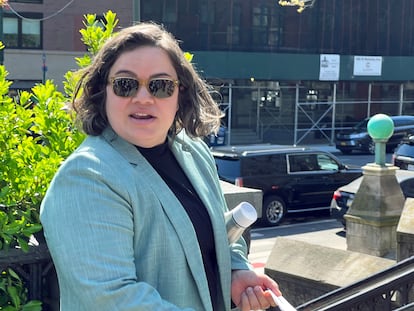Strike at New York’s Hispanic Society strike puts Sorolla exhibition on hold
The labor crisis faced by the organization – which houses the largest collection of the Spanish painter outside of Spain – is postponing the reopening of the museum. Employees are demanding better working conditions and denouncing negligence by the management


The Hispanic Society of America has been the New York home of Spanish artist Joaquín Sorolla since its founding in 1904. It also houses important art collections from Spain, Portugal and Latin America, including masterpieces by Goya, El Greco and Velázquez, among many others. It is situated in an old building in northern Manhattan – far from the New York museum circuit – but in the heart of the city’s Hispanic community.
Closed since 2017 due to a massive modernization plan, everything seemed to be ready to reopen this month. This was supposed to be the Sorolla Year, marking a century since the passing of the Spanish Valencian painter. The main building houses his monumental series of 14 paintings known as Vision of Spain, which was commissioned by the Hispanic Society’s founder – philanthropist Archer M. Huntington – following the success of two exhibitions held by the Spanish painter in 1909 and 1911. However, a workers’ strike has marred the calendar.
In addition to the distance between the demands of the workers and the offers made by the management, there are also two different ways of looking to the future. The Hispanic Society faces a dilemma: updating a museum that, for decades, has been a gigantic depository of artworks… or, preserving its essence. For employees, worsening working conditions are the principal concern, while they are also concerned with the state of 900 paintings and more than 6,000 drawings, along with about 750,000 books, photographs, sculptures and decorative arts.
A part of the workforce – unionized since 2021 – went on strike on March 27, after more than a year of negotiations. In addition to the economic demands – which the management claims are the sole cause of the conflict – many workers are frustrated by the lack of personnel and the poor treatment that the art collection receives. There are concerns about the lack of control over the storage temperature and the unfilled vacancies in the technical staff that must watch over the collections. Striking workers have also mentioned the threat of outsourcing positions or services, which the management denies it is doing. As with any other unionized action in the United States, resistance to mobilization is the norm.
“The strike has shown that the administration is willing to put priceless treasures at risk,” says Patrick Lenaghan, the head of iconography and a curator at the Hispanic Society Museum for the past 28 years. “We’ve had a serious shortage of personnel and our incredible collection is in danger due to a lack of adequate safeguards,” he adds, mentioning five floods (caused by rain) in the building’s basement – which houses part of the collection – as well as mold in the book restoration workshop
While flatly rejecting these claims, Guillaume Kientz – director of the Hispanic Society – shows EL PAÍS the rooms that will open to the public: “the Sorolla room [with the Vision of Spain], the main patio and the library.” Including “the remodelling of the facilities, warehouses and offices – as well as the roof and the plumbing” in the main building, the renovations have cost a total of $8 million.
“I’m not going to talk about the strike, because we’re negotiating and agree on almost everything… hopefully it can be resolved very soon,” Kientz notes. Regarding health insurance coverage, he says that “it will not vary for contract workers… we’ll negotiate these conditions with [new workers].”
The fight over working conditions isn’t different from the negotiations taking place in many other American companies, but the novelty is that the strike (directly or indirectly) affects works of art valued at millions of dollars. “It’s not only an economic question, but also [about] the demand for professional museum standards,” the curator warns.
Kientz denies that the Hispanic Society’s legacy is at risk. “The renovation has already improved things a lot and it’s going to further improve conditions. It’s something that was never done, there was very little maintenance during the last 50 years… some liked [the building] better as it was before, a quasi-closed museum, with little public engagement. But we have to reach the people, share the collections and do what museums and libraries do.”
The library – one of the largest Hispanic research centers in the world – will be open to scholars, the director explains.
Lenaghan emphasizes that the Hispanic Society of America houses “the best library of manuscripts and rare books in Latin America outside of Spain,” but he also makes it clear that, for instance, “the restorer cannot work because now they don’t know what to do with her workshop [after the renovation].” The collection of photographs “is also the best of all of Latin America.”
“[The Hispanic Society Museum] is on a par with the Frick Collection or the Morgan Library,” Lenaghan says, naming other prominent New York institutions, “but we don’t earn the same as their employees, nor are we as well-regarded.”
The director alludes to the inertia of the institution to explain this popularity deficit. “It’s little-known because it had few exhibitions… it always taught the same things and it was considered to be more of a research center than a museum that attracts the public. We have to change the way we approach people, [we must] be more proactive and be more open to new discourses on art history.” Future plans call for the creation of a new cultural district in the area, along with another 10 museums and 20 cultural entities.
The reform “showcases a void that doesn’t correspond to the legacy and dimension of the collection,” says another striker, a curator with years of experience in state museums in Latin America. “[The Hispanic Society of America] has no direction – it’s a slow-motion derailment.”
“We were a staff of 40 people in the 1990s… now, we don’t even reach 25,” Lenaghan notes, although the company indicates that, since 2021, it has hired eight additional staff members.
“One person does the work of four. This shows in the restoration and conservation processes. We’ve gone from three restorers to one, but the work all falls on them. A bottleneck is created. In addition, there are pieces that have traveled a lot – to Madrid, Mexico, other places in the US, Canada or London – and the risk of transit and handling is significant. It’s a diverse collection that requires highly-specialized personnel.”
Precisely last Thursday, 150 pieces from the Treasures exhibition were returned to the mansion on Broadway Street from the Royal Academy in London. Among them, a Goya and a Velázquez. The strike committee denounced negligence in the transfer, with photos showing the open back of the moving truck and several pieces being left in plain sight, without appropriate supervision. “Instead of professionals, the [Hispanic Society] turned to contractors who, according to the workers, endangered the art due to their poor handling and lack of security,” the committee denounced.
The allegations of negligence particularly irritate the director. “We work with the same company as the Metropolitan Museum. The fact that the workers themselves have disclosed details and images of the transfer – with the security risks that this implies – is crossing a red line. I was very shocked that the date, time and content [of the truck] were known and shared with people who have nothing to do with the museum. There’s a video of a person shouting in the street: ‘Look, look, there’s a $30 million Velázquez!’ This is confidential information. For me and my colleagues, it’s been a shock to see professionals act in this way… it’s something very serious.”
Judging by the pre-renovation photos that Kientz shows EL PAÍS on his laptop – snapshots of holes in the ceiling, rusty pipes almost bursting, a hodgepodge of negatives, stacks of files and papers – the Hispanic Society was crying out for help.
“The museum didn’t look good and there’s still a lot to do… but in two years, we’ve come a long way, thanks also to the donors and, of course, to the mobilization of the team that has helped, so it saddens me to see what’s happening.”
The workers are showing their willingness to continue the strike, with the state of New York granting subsidies in the form of unemployment benefits. Until the strike ends, the home of 243 works by Sorolla – his largest collection outside of Spain – remains closed. However, the management hopes to be able to open later this spring.
In 1909, an exhibition by the Valencian attracted no less than 160,000 visitors in one month. Today, the main courtyard of the mansion – which people with reduced mobility can access via ramps and lifts – hosts an exhibition of Sorolla’s works that takes your breath away. His paintings are in dialogue with kinetic pieces by the Venezuelan Jesús Rafael Soto, who was born a century ago. In the calendar, there’s also a slot for the 50th anniversary of Picasso’s death.
Next to the splendid tomb of the Duchess of Albuquerque, an ornamental work acquired by Huntington adorns one side of the courtyard. Nearby, the Sorollas await their latest moment of glory.
Sign up for our weekly newsletter to get more English-language news coverage from EL PAÍS USA Edition
Tu suscripción se está usando en otro dispositivo
¿Quieres añadir otro usuario a tu suscripción?
Si continúas leyendo en este dispositivo, no se podrá leer en el otro.
FlechaTu suscripción se está usando en otro dispositivo y solo puedes acceder a EL PAÍS desde un dispositivo a la vez.
Si quieres compartir tu cuenta, cambia tu suscripción a la modalidad Premium, así podrás añadir otro usuario. Cada uno accederá con su propia cuenta de email, lo que os permitirá personalizar vuestra experiencia en EL PAÍS.
¿Tienes una suscripción de empresa? Accede aquí para contratar más cuentas.
En el caso de no saber quién está usando tu cuenta, te recomendamos cambiar tu contraseña aquí.
Si decides continuar compartiendo tu cuenta, este mensaje se mostrará en tu dispositivo y en el de la otra persona que está usando tu cuenta de forma indefinida, afectando a tu experiencia de lectura. Puedes consultar aquí los términos y condiciones de la suscripción digital.
More information
Archived In
Últimas noticias
The story of the Málaga virus: The code that haunted Google’s cybersecurity center director for 30 years
The impact of Ecuador’s mega-prison: A polluted river, cleared forests and military checkpoints
Corinne Low: ‘I’m more concerned about the female happiness gap than the gender wage gap’
Trump traveled on Epstein’s plane ‘many more times’ than previously thought, according to new documents
Most viewed
- The low-cost creative revolution: How technology is making art accessible to everyone
- Christian Louboutin: ‘Young people don’t want to be like their parents. And if their parents wear sneakers, they’re going to look for something else’
- All the effects of gentrification in one corner of Mexico’s Colonia Roma
- Liset Menéndez de la Prida, neuroscientist: ‘It’s not normal to constantly seek pleasure; it’s important to be bored, to be calm’
- Christmas loses its festive spirit: ICE fears cast shadow over religious celebrations










































